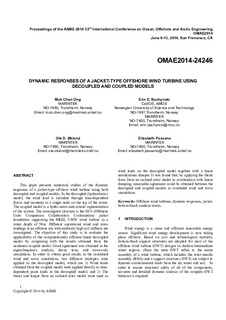| dc.contributor.author | Ong, Muk Chen | |
| dc.contributor.author | Bachynski, Erin Elizabeth | |
| dc.contributor.author | Økland, Ole David | |
| dc.contributor.author | Passano, Elizabeth Anne | |
| dc.date.accessioned | 2017-11-29T09:53:57Z | |
| dc.date.available | 2017-11-29T09:53:57Z | |
| dc.date.created | 2014-10-20T16:02:48Z | |
| dc.date.issued | 2014-06 | |
| dc.identifier.citation | ASME 2014 33rd International Conference on Ocean, Offshore and Arctic Engineering - Volume 9B: Ocean Renewable Energy | nb_NO |
| dc.identifier.isbn | 978-0-7918-4554-7 | |
| dc.identifier.uri | http://hdl.handle.net/11250/2468425 | |
| dc.description.abstract | This paper presents numerical studies of the dynamic responses of a jacket-type offshore wind turbine using both decoupled and coupled models. In the decoupled (hydroelastic) model, the wind load is included through time-dependent forces and moments at a single node on the top of the tower. The coupled model is a hydro-servo-aero-elastic representation of the system. The investigated structure is the OC4 (Offshore Code Comparison Collaboration Continuation) jacket foundation supporting the NREL 5-MW wind turbine in a water depth of 50m. Different operational wind and wave loadings at an offshore site with relatively high soil stiffness are investigated. The objective of this study is to evaluate the applicability of the computationally efficient linear decoupled model by comparing with the results obtained from the nonlinear coupled model. Good agreement was obtained in the eigen-frequency analysis, decay tests, and wave-only simulations. In order to obtain good results in the combined wind and wave simulations, two different strategies were applied in the decoupled model, which are 1) Wind loads obtained from the coupled model were applied directly as time-dependent point loads in the decoupled model; and 2) The thrust and torque from an isolated rotor model were used as wind loads on the decoupled model together with a linear aerodynamic damper. It was found that, by applying the thrust force from an isolated rotor model in combination with linear damping, reasonable agreement could be obtained between the decoupled and coupled models in combined wind and wave simulations. | nb_NO |
| dc.language.iso | eng | nb_NO |
| dc.publisher | ASME Digital collection | nb_NO |
| dc.relation.ispartof | 33rd International Conference on Ocean, Offshore and Arctic Engineering Volume 9B: Ocean Renewable Energy | |
| dc.relation.ispartofseries | ASME Proceedings | Ocean Renewable Energy;OMAE2014-24246 | |
| dc.rights | Navngivelse-Ikkekommersiell-DelPåSammeVilkår 4.0 Internasjonal | * |
| dc.rights.uri | http://creativecommons.org/licenses/by-nc-sa/4.0/deed.no | * |
| dc.subject | Dynamic response | nb_NO |
| dc.subject | Offshore wind turbines | nb_NO |
| dc.title | Dynamic responses of a jacket-type offshore wind turbine using decoupled and coupled models | nb_NO |
| dc.type | Chapter | nb_NO |
| dc.description.version | acceptedVersion | nb_NO |
| dc.rights.holder | The authors | nb_NO |
| dc.identifier.doi | 10.1115/OMAE2014-24246 | |
| dc.identifier.cristin | 1165409 | |
| dc.relation.project | Norges forskningsråd: 193823 | nb_NO |
| cristin.unitcode | 7566,8,0,0 | |
| cristin.unitcode | 7566,9,0,0 | |
| cristin.unitname | Ocean Engineering | |
| cristin.unitname | Hydrodynamikk | |
| cristin.ispublished | true | |
| cristin.fulltext | postprint | |
| cristin.qualitycode | 1 | |

